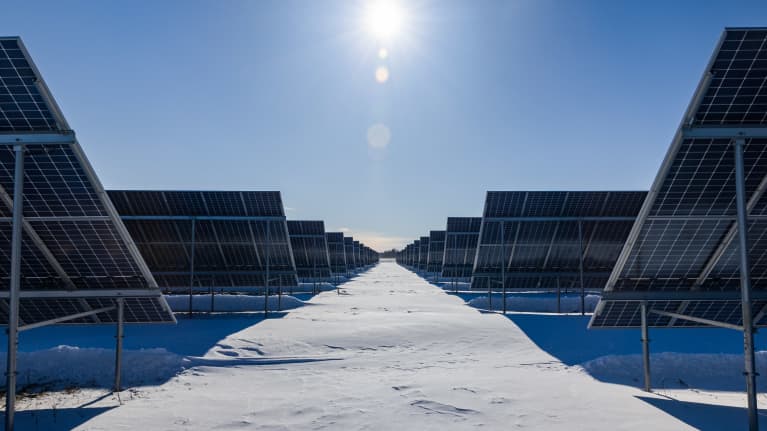Hundreds of new solar power projects are planned or being mapped out in Finland. Fields of solar panels are springing up at such a fast pace that some industry experts believe that the national grid won't be able to keep up with the pace.
Following on from the wind power boom, solar electricity production has begun to get more attention. Solar panels for small houses are already fairly commonplace, but now companies are also moving to build up solar electricity production capacity on an industrial scale.
"Since 2019, capacity has doubled and doubled again. We're beginning to see hundreds of hectares of solar panels," says Onni Härmä, customer manager at the Finnish power grid operator Fingrid.
Fingrid estimates that solar electricity production capacity in the country will increase more than tenfold from the current level by 2030, to approximately 7,000 megawatts.
"In terms of surface area, that is about 10,000 hectares. About half of that will be industrial projects built on peatlands and other large open areas," Härmä explains.
At peak power, this level of capacity would roughly correspond to about a fifth of Finland's current maximum production.
At present, there there are fewer than ten industrial-scale solar power plants in Finland. However, there are plenty of new projects pending, mainly in southern Finland.
"There are currently 10–20 announced projects of ten hectares or even hundreds of hectares in size. There are hundreds more surveys planned or mapping projects going on," Härmä notes.
Share of home panels falling
Currently, the country has approximately 600 megawatts of solar electricity capacity. About 75–80 percent of that is on the roofs of private homes and housing associations, and the rest consists of commercial solar panels in fields, peatlands, and, for example, on the roofs of supermarkets.
Although small-house installations continue to be popular, the share of corporate-owned, large-scale industrial projects will rise to about half of the total capacity within the next few years.
One big player is the S-Group cooperative which already has solar power systems in around 200 locations, with a total of around 110,000 solar panels. The S-Group says that it intends to build more solar power, mainly on roofs or on the grounds of its commercial properties.
"Larger, ground-based systems are being looked at in connection with our own wind farms," says Mikko Halonen, CEO of the S-Group's energy company S-Voima.
Solar power now provides approximately two percent of the electricity used by the S-Group.
"Locally, solar panels can produce a significant part of a commercial site's electricity consumption. For example, the 750 panels on the roof of the Prisma hypermarket in Sastamala cover half of the entire market's electricity consumption in the summer," Halonen explains.
Another major operator is Ilmatar Energy, which is better known for its wind farms. It is launching a solar park at Ähtäri in the South Ostrobothnia region. When completed, the park will be one of the largest in Finland, and its output will meet the electricity needs of about 2,000 single-family homes. Production is scheduled to begin in 2024.
The City of Helsinki's energy company Helen is also accelerating its investments in solar energy. Its Nurmijärvi pilot plant will be connected to the grid this month. According to current plans, industrial scale solar parks to be built in Lohja and Kalanti, in the south and southwest, will start production in 2024. In 2030, solar and wind electricity is to make up 30 percent of Helen's total electricity production.
Too much, too fast?
According to Fingrid's Onni Härmä, what is striking about solar park projects is the speed with which the plans are being implemented.
"According to developers, planned solar power plants may be operational in 2–3 years, that is very quick," he points out.
From Fingrid's point of view, speed may also be a problem, especially in eastern Finland.
Many municipalities in eastern parts of the country have begun to consider constructing solar power capacity. Because of the proximity of the border, the construction of wind turbines there is practically zero due to opposition from the Defense Forces which says that wind farms cause interference to radar systems.
If large-scale solar power farms begin to be built in eastern Finland, the capacity of Fingrid's power line network may become a bottleneck.
Upgrading carrying capacity could easily take 7–8 years, so solar power plants completed within a couple of years may have to wait to be connected to the national power grid.
Would you like a roundup of the week's top stories in your inbox every Thursday? Then sign up to receive our weekly email.
